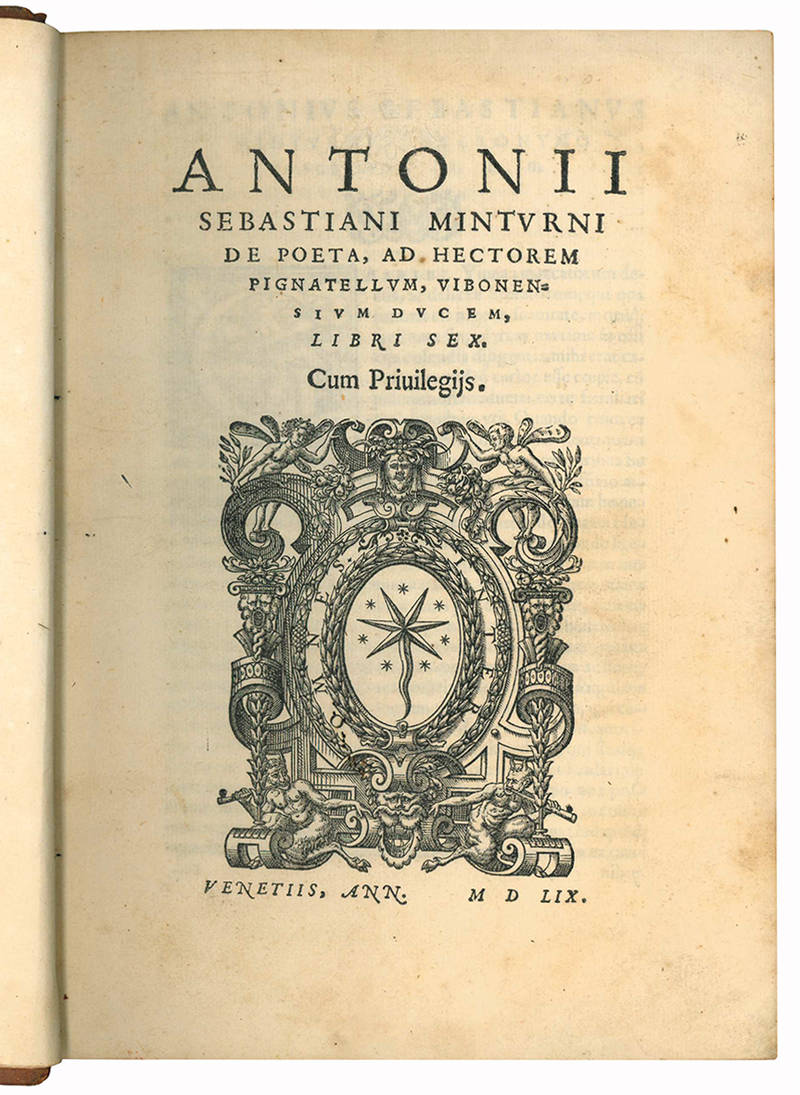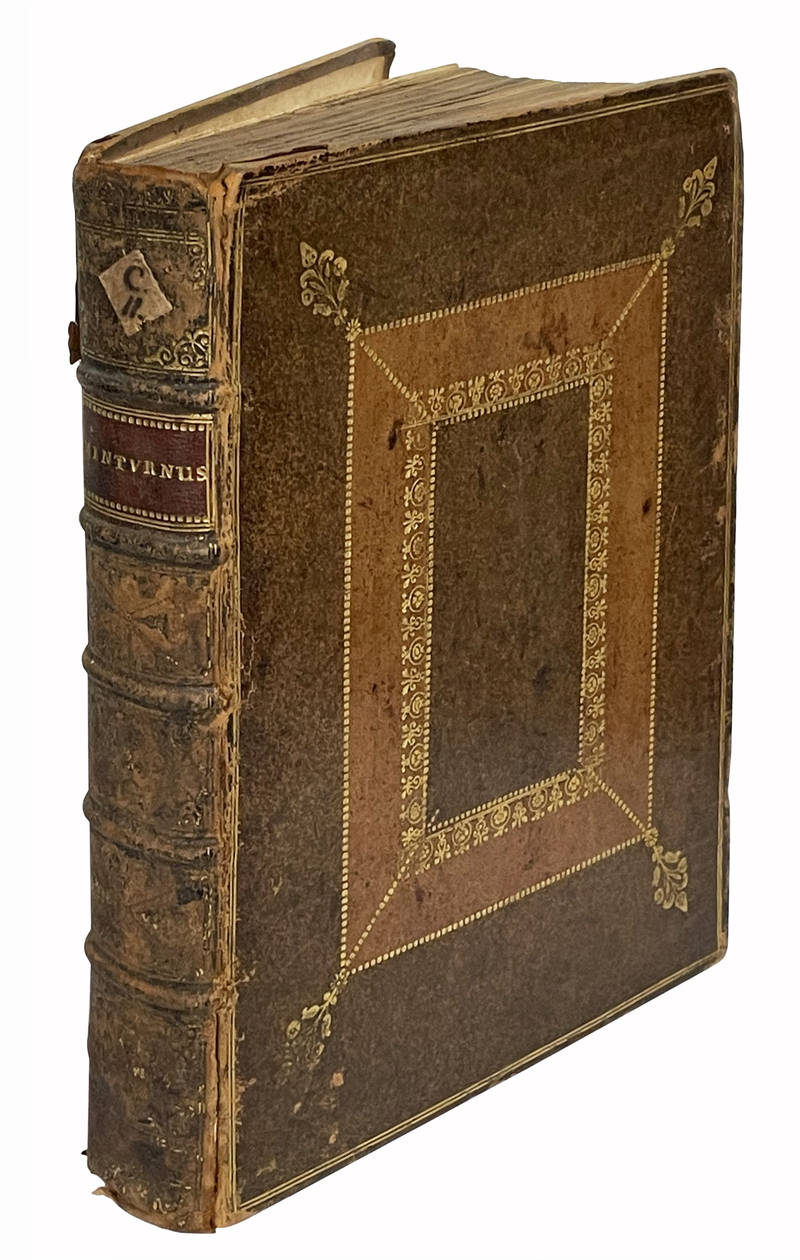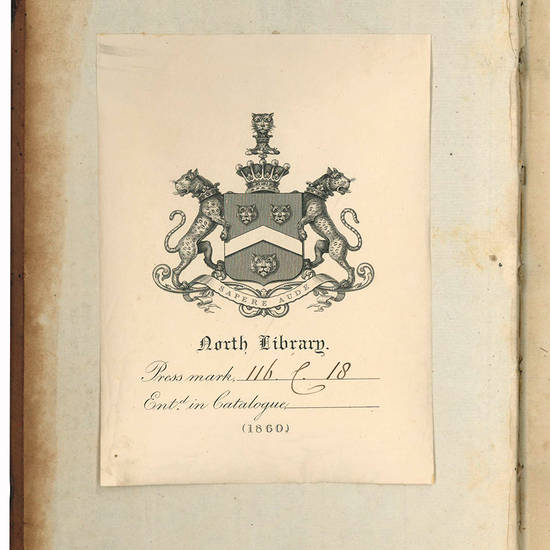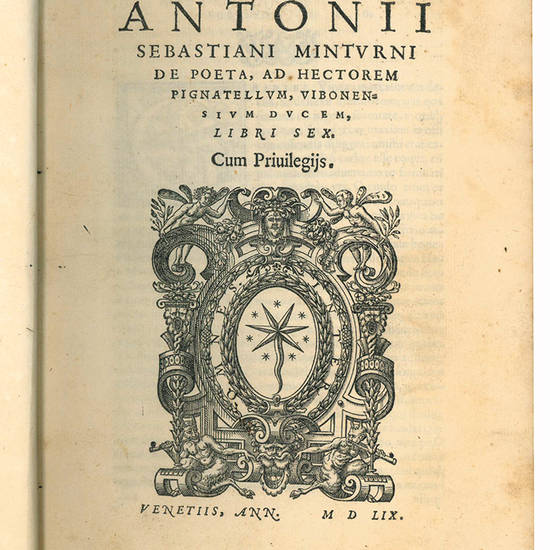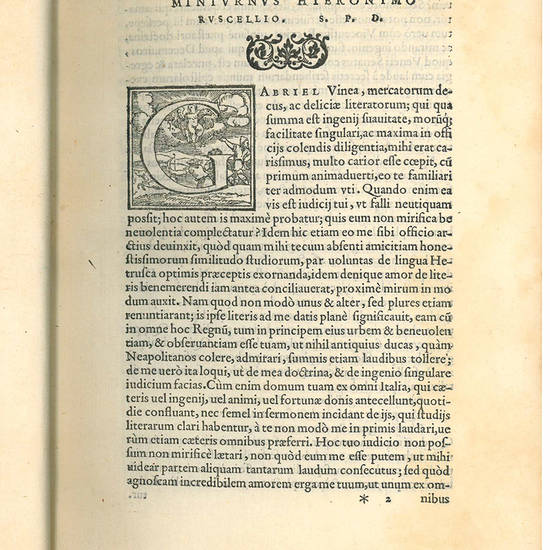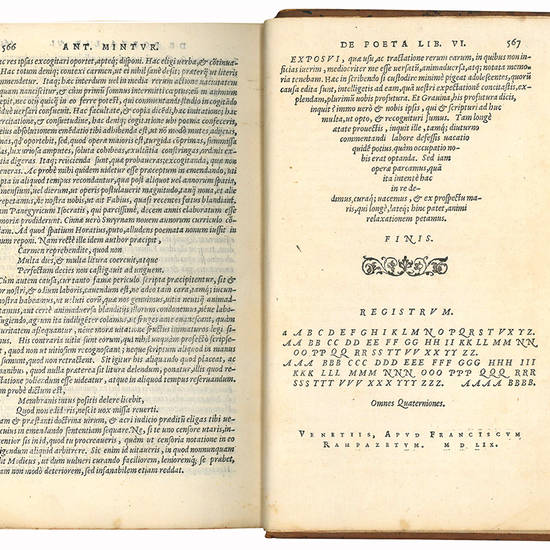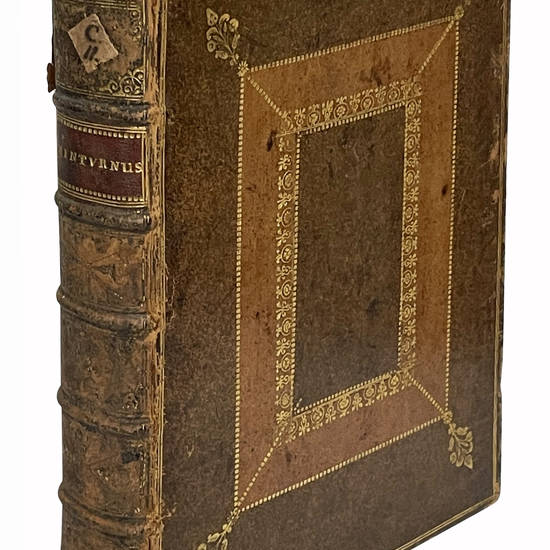“A COLOSSUS AMONG ARTES POETICAE” (WEINBERG)
4to (205x145 mm). [8], 567, [1 blank] pp. Collation: *4 A-BBBB4. Ziletti's device on title page. 18th-century panelled calf gilt, spine gilt in compartments, red morocco lettering piece, sprinkled edges (extremities and spine rubbed). On the front pastedown engraved bookplate of the Earls of Macclesfield (cf. The Library of the Earls of Macclesfield, Part Twelve, London, Sotheby's, 2008, no. 4619). A very good copy.
First edition. “In comparison with its fairly short, fairly meager, fairly single-minded predecessors, Antonio Sebastiano Minturno's De poeta (1559) is a colossus among ‘artes poeticae'. The six books of dialogue make an aggregate of almost six hundred pages. Besides, rather than drawing almost exclusively upon the Ars poetica, the work incorporates (in addition to Horace) almost all of the Poetics and abundant materials from Plato (Republic, Laws, Ion, etc.), from Aristotle's Rhetoric, from Quintilian, and from all the rhetorical writings of Cicero. It is thus the first of the really extensive arts of poetry, the first to attempt a detailed discussion of every aspect of doctrine and technique, the first to broaden considerably the range of references and ‘authorities'. These features are not without important consequences for the nature of the work itself; for they give to it a wide-ranging eclecticism, which is reflected in the theory ultimately evolved by Minturno […] From the way these various distinctions are developed, from the miscellaneous shutting off in the directions of the poet or nature or the poem or the audience, it should be clear the Minturno's treatise remains primarily eclectic and syncretic. None of the term of ultimate reference comes to dominate the others, to impose a systematic organization upon the work. Insofar as there is any ordering of ideas, it is an ordering to rhetorical principles. At one end of each of the chains of relationship is an effect upon the audience; at the other end, some faculty of the poet capable of producing that effect; in the middle, the poem serving as a means or instrument […] For Minturno, the poet, his art, and his faculties occupy a similar position of pre-eminence. What Minturno does, essentially, is to take over the whole rhetorical schematism of his times, to substitute for the orator the poet, and to introduce - at what seemed to him to be the most likely points in the argument - all the know materials on the art of poetry. In this way both the Poetics and the Ars poetica are, if not assimilated, at least incorporated into a vast compendium on the art” (B. Weinberg, A History of Literary Criticism in the Italian Renaissance, Chicago-Toronto, 1961, pp. 737-743).
Antonio Sebastiani was born in Minturno, near Latina, around 1497. In 1511 he moved to Sessa Aurunca to study with Agostino Nifo, whom he then followed to Padua and Pisa, where, by the end of 1520, he became a lecturer in poetics and oratory. At the end of 1521 he moved on to Rome as a lecturer in theology and philosophy. In Rome, thanks perhaps to the intercession of another student of Nifo, Galeazzo Florimonte, he came into contact with Ludovico Beccadelli, Girolamo Seripando, Gasparo Contarini and Filippo Gheri, later secretary to Cardinal Giovanni Morone. In 1524 he took up service as tutor to the Colonna family in Genazzano, and it was around this time that he entered the Order of the Theatines. The following year he returned to Naples to resume his studies; there he used to hang out with Girolamo Carbone, Pomponio Gaurico, Pietro Summonte, Pietro Gravina, and noblewomen such as Maria di Cardona, Giulia Gonzaga and Beatrice d'Appiano d'Aragona. It is very likely that in this period he adopted the name Minturno (from Minturnae, the Latin name of his hometown), which conferred a humanistic gravitas to his person. From October 1527 he was tutor first in the household of Camillo Pignatelli, count of Borrello, and later of Girolamo and Fabrizio Pignatelli, sons of Ettore, viceroy of Sicily. Most of Sebastiani Minturno's literary production is concentrated in the period 1526-1542. The proximity to Francesco Maria Molza, Claudio Tolomei, Luigi Tansillo and to Spanish literary circles enabled him to develop already at the beginning of his literary activity aesthetic-critical notions and theories about his production, which were later poured into the final drafts of De poeta and Arte poetica. In 1542, after fifteen years of service with the Pignatelli family, gratified by an annual pension of two hundred ducats, he returned to Minturno. Already the following year, however, he went to Naples to teach theology but, because of the problems that arose in the attempt to impose the Inquisition in the city, he was forced to move to Sicily, where he remained at least until 1548; on this occasion his entire library was looted and dismembered, to be recovered only later thanks to the collaboration of Andrea Cossa. To this period dates the composition of the Rime and the Amore innamorato, works both conceived within the literary circle orbiting around Maria di Cardona. From 1548 to 1551 he returned to Naples, and from 1554 to 1558 he lived in Calabria. In 1556 he tried to have De poeta printed in Venice (but the edition would actually not be prepared until 1559), and in 1558 he was appointed bishop of Ugento. Through the intercession of Girolamo Seripando he was summoned to the Council of Trent. The composition of the Diocles, Poemata, Orationes, a lost Moseida, and other works and writings testifies to the author's true interests in Latin production and highlights his interest in transferring the codes and models of ancient Greek poetry to the biblical theme. In 1565 he was appointed bishop of Crotone. Between 1564 and 1565 he began the compilation of the Synopsis historiae patriae de episcopis Minturnensibus et Traictensibus later published by De Gennaro in 1570. Minturno's most important works are undoubtedly De poeta, the four parts of the Arte poetica, the Amore innamorato, and the Canzoni sopra i salmi. He died in Crotone in January 1574, while still intent on writing and conceiving new literary works (cf. G. Tallini, Sebastiani Minturno, Antonio, in: “Dizionario Biografico degli Italiani”, vol. 91, 2018, s.v.).
Edit 16, CNCE36263.
[11030]

